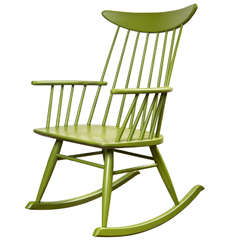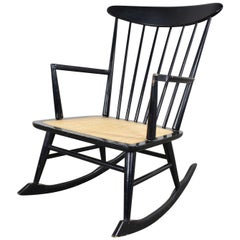Conant Ball Rocker
Recent Sales
Vintage 1950s American Mid-Century Modern Rocking Chairs
Mid-20th Century Scandinavian Modern Rocking Chairs
Wood
Vintage 1950s American Mid-Century Modern Rocking Chairs
Maple
Conant Ball for sale on 1stDibs
While the Conant Ball Company was initially known for its reproductions of period furniture in the Colonial style, the Massachusetts manufacturer eventually garnered national recognition as a leader in the production of solid rock maple dressers, tables and other pieces as well as for its popular modernist collections such as its large Sierra line designed by Colman Zola and its American Modern collection created by Russell Wright.
In the 1800s, the small town of Gardner, Massachusetts, saw a boom in start-up furniture factories. There was Westminster transplant Nichols and Stone, Standard Chair of Gardner Inc. — a maker of American Craftsman-style furnishings — Heywood-Wakefield, which moved into the manufacture of furniture with steam-bent wood frames and cane or wicker seating, and later, what was once the largest chair in the world was built in the city to attract tourists and to sell …chairs.
Conant Ball’s first product was its chairs — there were inviting chairs with woven cane seats and the company later earned acclaim for its Windsor designs. But before it got its name in 1909, there was a chair shop called Jackson & Greenwood. Abner and Leander White purchased the modest-sized business and renamed it A. White and Co. John Conant and his brother Charles joined later and it eventually operated under the name Conant Brothers and Co. Later, the firm’s name changed again with the addition of Carlos Ball, who helmed the company’s Boston location. Between Conant’s and Ball’s passings in 1891 and 1909, Charles Brooks and a succession of family members took the company into the 20th century as Conant Ball Co.
Conant Ball’s comely mid-century modern furniture — its low-profile lounge chairs, sleek tables and more — owe to partnerships with designers such as Leslie Diamond and Russel Wright.
Diamond and Wright created a variety of solid wood furniture including dining room chairs, side tables and dressers. The former created a line called ModernMates that featured solid birch office chairs, nightstands and dining chairs with curved spindle backs, while Wright, who had created some Art Deco furnishings for Heywood-Wakefield, designed charming, light-colored maple furniture called American Modern for Conant Ball. The name is said to have been given to him by his romantic partner — in 1927, Wright married artist and sculptor Mary Einstein. Under her guidance, Wright's attractive, functional designs for the home gained renown, leading to commissions by prestigious companies like the Steubenville Pottery Company.
Conant Ball’s momentum slowed in 1986 and ownership changed hands once more. By 1990, the firm would no longer produce furniture under its own name.
Find antique Conant Ball tables, chairs, case pieces and storage cabinets on 1stDibs.
A Close Look at Mid-century-modern Furniture
Organically shaped, clean-lined and elegantly simple are three terms that well describe vintage mid-century modern furniture. The style, which emerged primarily in the years following World War II, is characterized by pieces that were conceived and made in an energetic, optimistic spirit by creators who believed that good design was an essential part of good living.
ORIGINS OF MID-CENTURY MODERN FURNITURE DESIGN
- Emerged during the mid-20th century
- Informed by European modernism, Bauhaus, International style, Scandinavian modernism and Frank Lloyd Wright’s architecture
- A heyday of innovation in postwar America
- Experimentation with new ideas, new materials and new forms flourished in Scandinavia, Italy, the former Czechoslovakia and elsewhere in Europe
CHARACTERISTICS OF MID-CENTURY MODERN FURNITURE DESIGN
- Simplicity, organic forms, clean lines
- A blend of neutral and bold Pop art colors
- Use of natural and man-made materials — alluring woods such as teak, rosewood and oak; steel, fiberglass and molded plywood
- Light-filled spaces with colorful upholstery
- Glass walls and an emphasis on the outdoors
- Promotion of functionality
MID-CENTURY MODERN FURNITURE DESIGNERS TO KNOW
- Charles and Ray Eames
- Eero Saarinen
- Milo Baughman
- Florence Knoll
- Harry Bertoia
- Isamu Noguchi
- George Nelson
- Danish modernists Hans Wegner and Arne Jacobsen, whose emphasis on natural materials and craftsmanship influenced American designers and vice versa
ICONIC MID-CENTURY MODERN FURNITURE DESIGNS
- Eames lounge chair
- Nelson daybed
- Florence Knoll sofa
- Egg chair
- Womb chair
- Noguchi coffee table
- Barcelona chair
VINTAGE MID-CENTURY MODERN FURNITURE ON 1STDIBS
The mid-century modern era saw leagues of postwar American architects and designers animated by new ideas and new technology. The lean, functionalist International-style architecture of Le Corbusier and Bauhaus eminences Ludwig Mies van der Rohe and Walter Gropius had been promoted in the United States during the 1930s by Philip Johnson and others. New building techniques, such as “post-and-beam” construction, allowed the International-style schemes to be realized on a small scale in open-plan houses with long walls of glass.
Materials developed for wartime use became available for domestic goods and were incorporated into mid-century modern furniture designs. Charles and Ray Eames and Eero Saarinen, who had experimented extensively with molded plywood, eagerly embraced fiberglass for pieces such as the La Chaise and the Womb chair, respectively.
Architect, writer and designer George Nelson created with his team shades for the Bubble lamp using a new translucent polymer skin and, as design director at Herman Miller, recruited the Eameses, Alexander Girard and others for projects at the legendary Michigan furniture manufacturer.
Harry Bertoia and Isamu Noguchi devised chairs and tables built of wire mesh and wire struts. Materials were repurposed too: The Danish-born designer Jens Risom created a line of chairs using surplus parachute straps for webbed seats and backrests.
The Risom lounge chair was among the first pieces of furniture commissioned and produced by celebrated manufacturer Knoll, a chief influencer in the rise of modern design in the United States, thanks to the work of Florence Knoll, the pioneering architect and designer who made the firm a leader in its field. The seating that Knoll created for office spaces — as well as pieces designed by Florence initially for commercial clients — soon became desirable for the home.
As the demand for casual, uncluttered furnishings grew, more mid-century furniture designers caught the spirit.
Classically oriented creators such as Edward Wormley, house designer for Dunbar Inc., offered such pieces as the sinuous Listen to Me chaise; the British expatriate T.H. Robsjohn-Gibbings switched gears, creating items such as the tiered, biomorphic Mesa table. There were Young Turks such as Paul McCobb, who designed holistic groups of sleek, blond wood furniture, and Milo Baughman, who espoused a West Coast aesthetic in minimalist teak dining tables and lushly upholstered chairs and sofas with angular steel frames.
Generations turn over, and mid-century modern remains arguably the most popular style going. As the collection of vintage mid-century modern chairs, dressers, coffee tables and other furniture for the living room, dining room, bedroom and elsewhere on 1stDibs demonstrates, this period saw one of the most delightful and dramatic flowerings of creativity in design history.
Finding the Right Rocking-chairs for You
The phrase “rocking chair” didn’t find its way into the dictionary until the mid-18th century. While most of the sitting furniture that we use in our homes originated in either England or France, the iconic rocking chair is a quintessentially American piece of furniture.
A Philadelphia cabinetmaker’s bill for a proto-rocking chair issued in 1742, which identified the seat as a “Nurse Chair with rockers,” is the earliest surviving evidence of this design’s humble beginnings. The nurse chair was a low side chair intended for nursing women, so giving it a soothing rocking motion made sense. Rocking chairs, which saw a curved slat affixed to the chairs’ feet so that they could be literally rocked, quickly gained popularity across the United States, garnering a reputation as a seat that everyone could love. They offered casual comfort without the expensive fabrics and upholstery that put armchairs out of many families’ budgets.
Rocking chairs are unique in that they don’t just offer a place to rest — they offer an opportunity to reminisce. The presence of one of these classic pieces stirs up our penchant for nostalgia and has the power to transform a space. They easily introduce a simple country feel to the city or bring the peaceful rhythm of a porch swing into a sheltered sunroom. Although craftsmen took to painting and stenciling varieties of the chairs that emerged in New England during the 19th century, the most traditional rocking chairs are generally unadorned seats constructed with time-tested materials like wood and metal. As such, a minimalist vintage rocking chair can be ushered into any corner of your home without significantly disrupting your existing decor scheme or the room’s color palette.
In the decades since the first rocker, top designers have made the piece their own. Viennese chair maker Michael Thonet produced a series of rockers in the middle of the 19th century in which the different curved steam-bent wood parts were integrated into fluid, sinuous wholes. Mid-century modernists Charles and Ray Eames added wooden rockers to their famous plastic shell armchair, while Danish designer Frank Reenskaug opted for teak and polished beech, introducing pops of color with small cushions (a precursor to the bold works that would follow in the 1970s and 1980s).
No matter your personal style, let 1stDibs pair you with your perfect seat. Deck out your porch, patio or parlor — browse the vintage, new and antique rocking chairs in our vast collection today.
- 1stDibs ExpertJanuary 27, 2025Russel Wright pottery was made in Steubenville, Ohio, through a partnership with the Steubenville Pottery Company. In 1935, Wright formed Russel Wright Associates with Irving Richards, an entrepreneur who had worked with Lightolier and would later establish Raymor. In collaboration with Richards, Wright debuted the first line of American Modern dinnerware in 1939. Steubenville continued to produce it for two decades. The line sold over 200 million pieces during its 20 years of production. On 1stDibs, find a collection of Russel Wright furniture and tableware.

